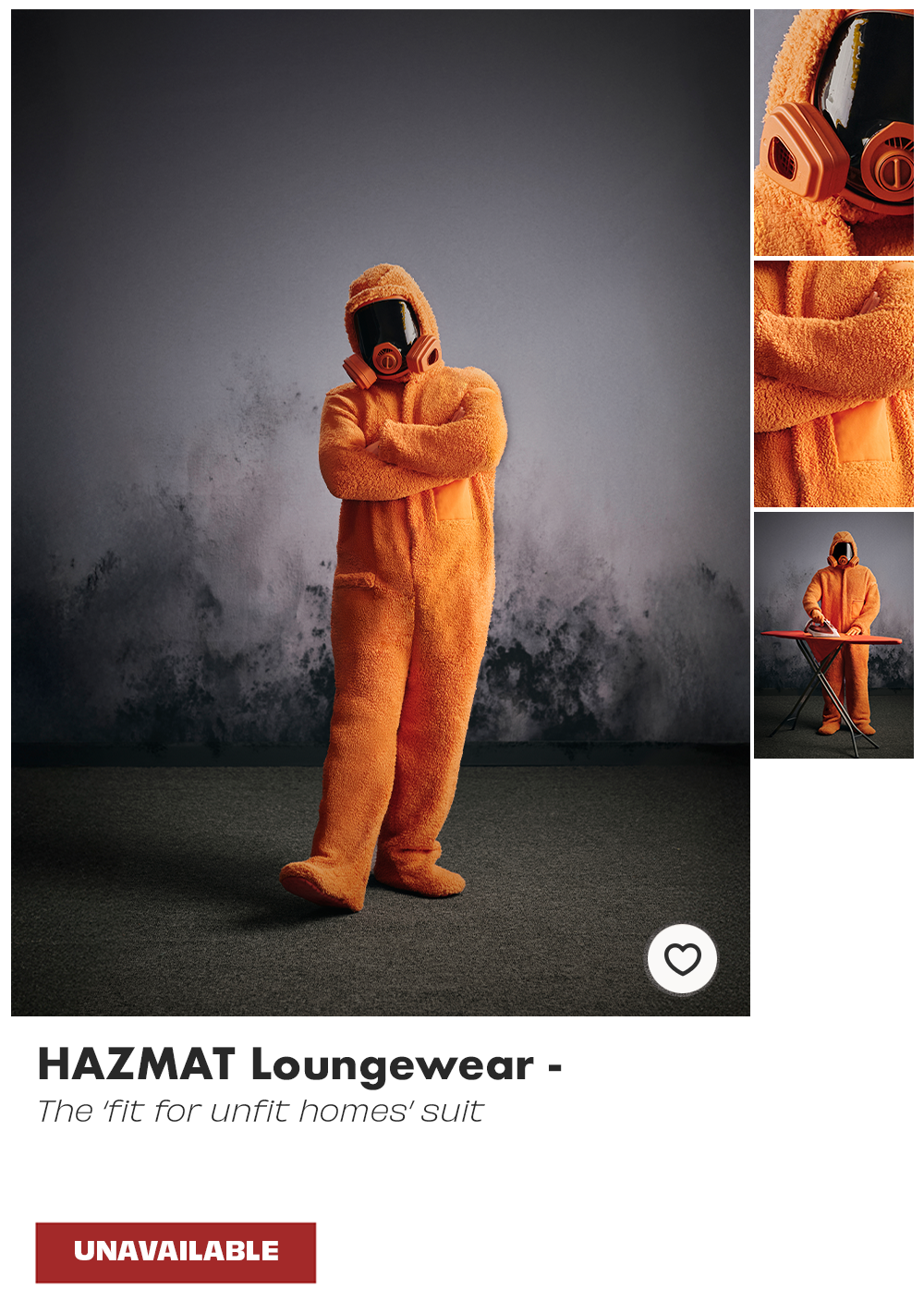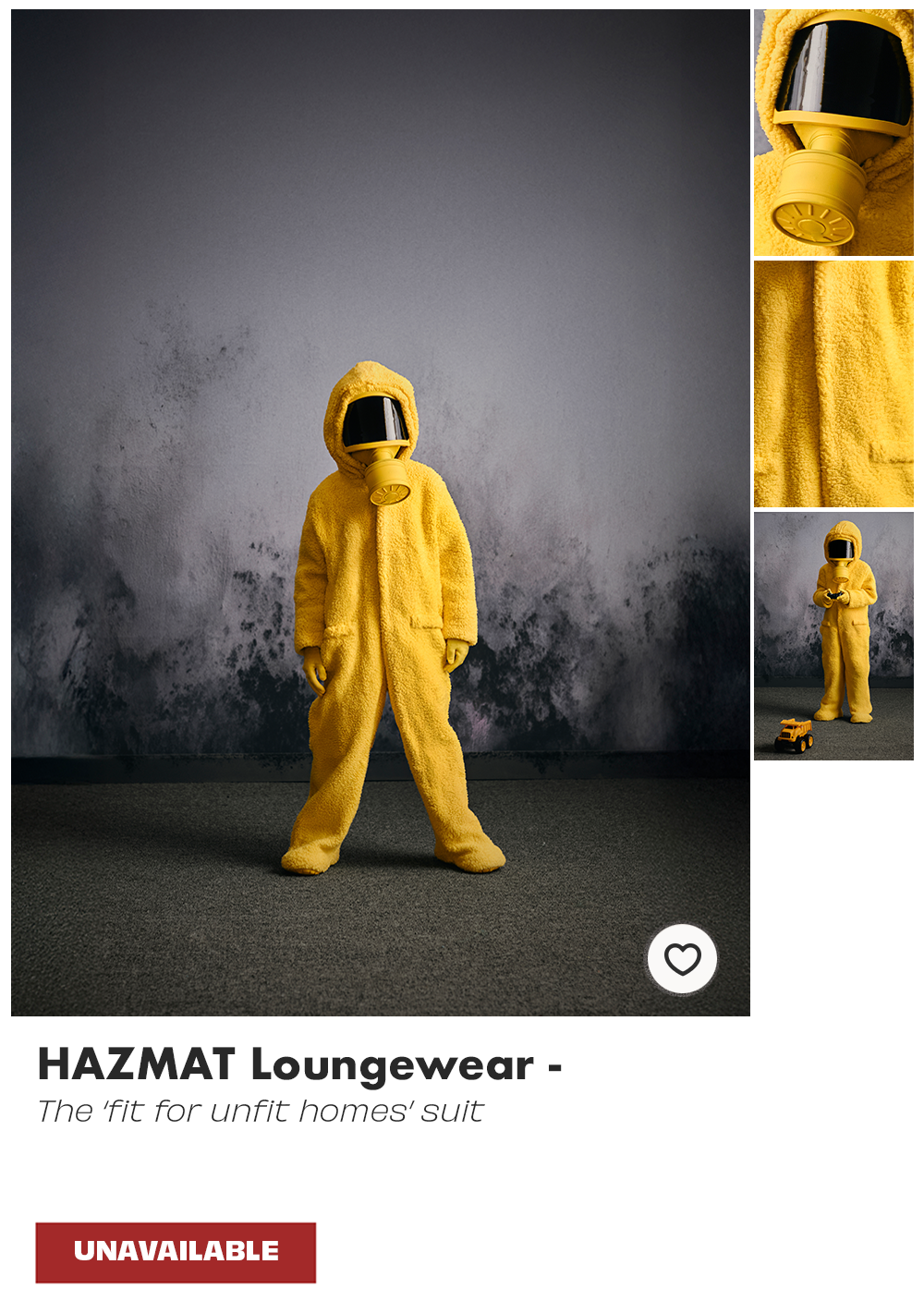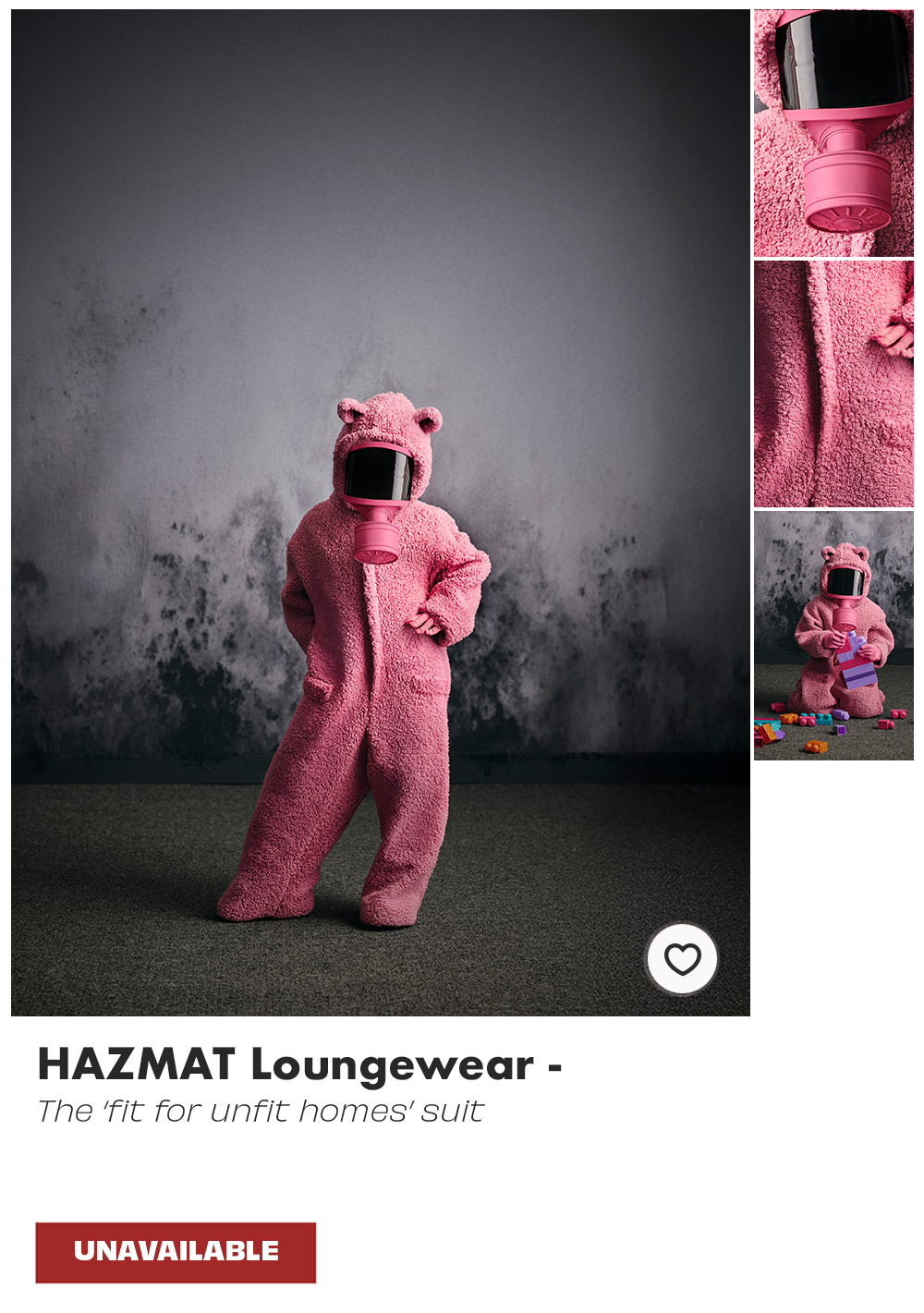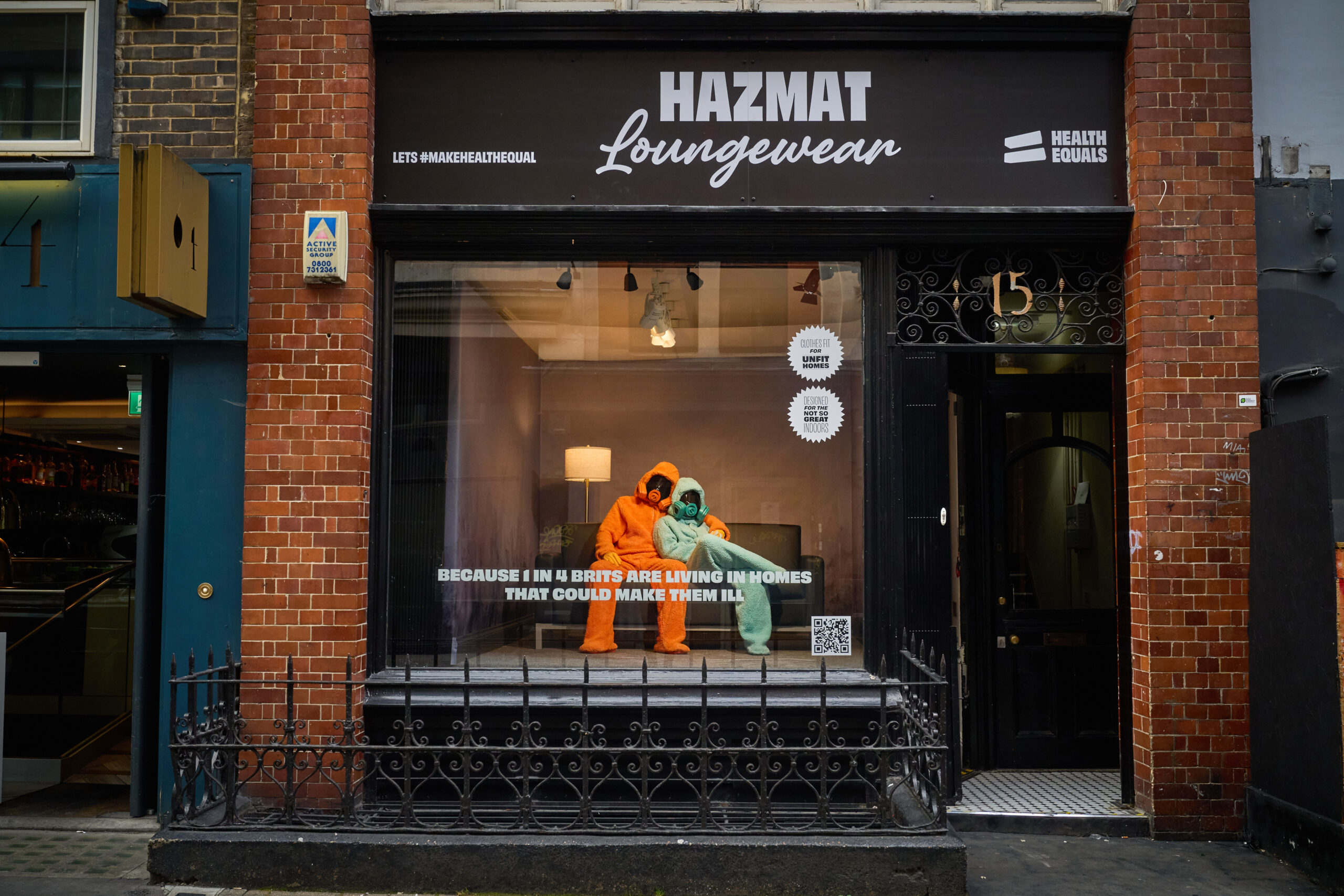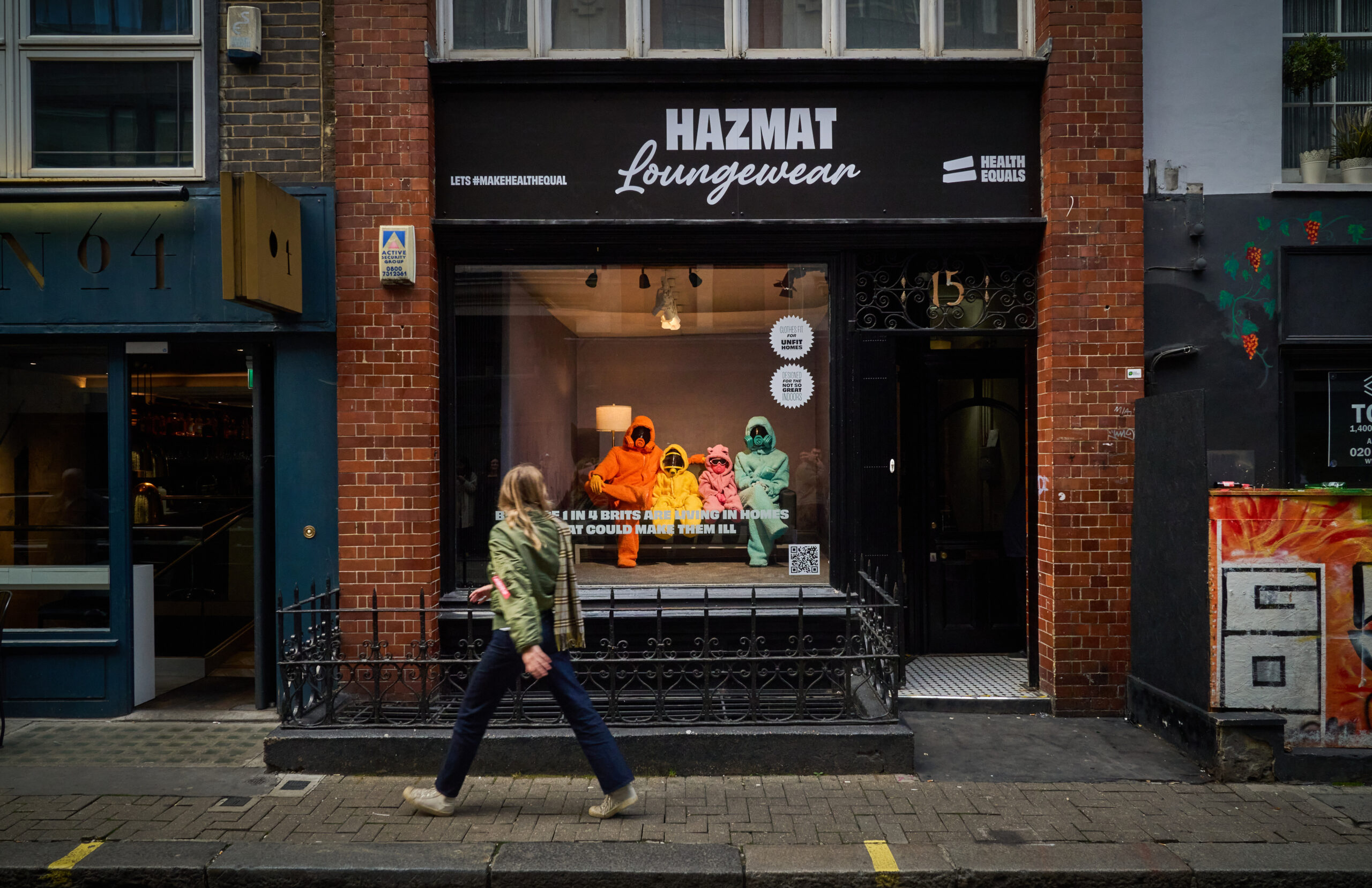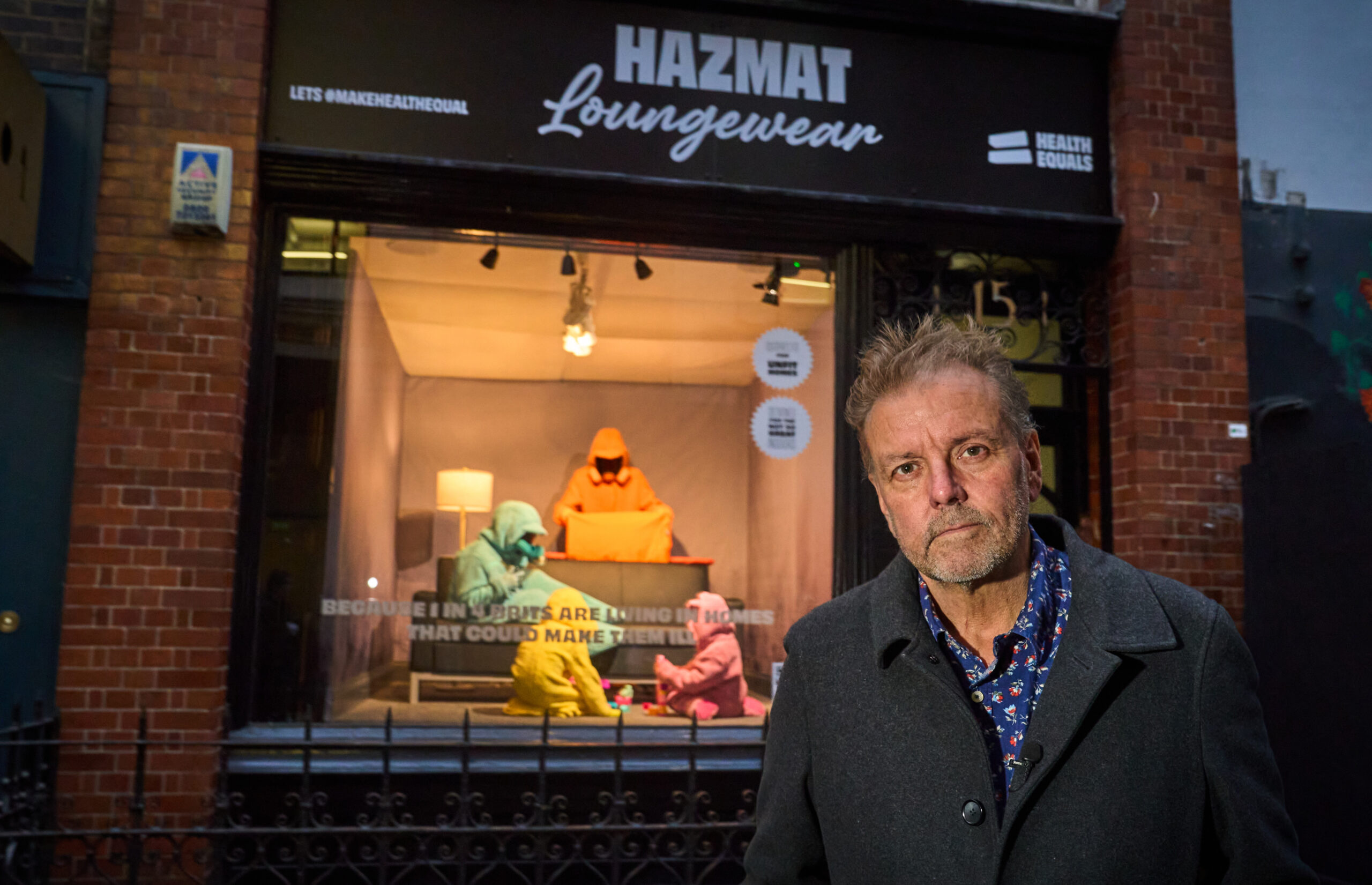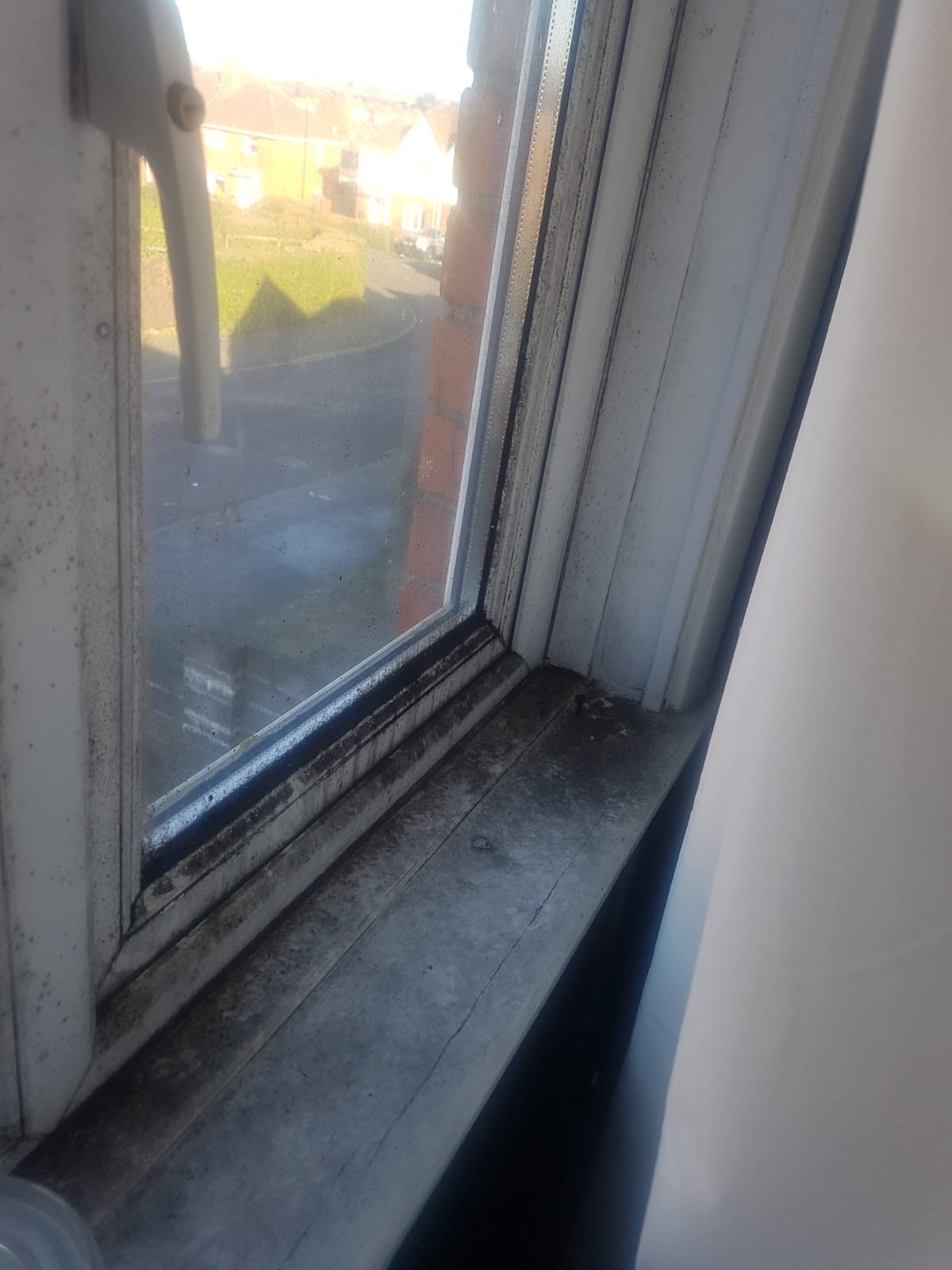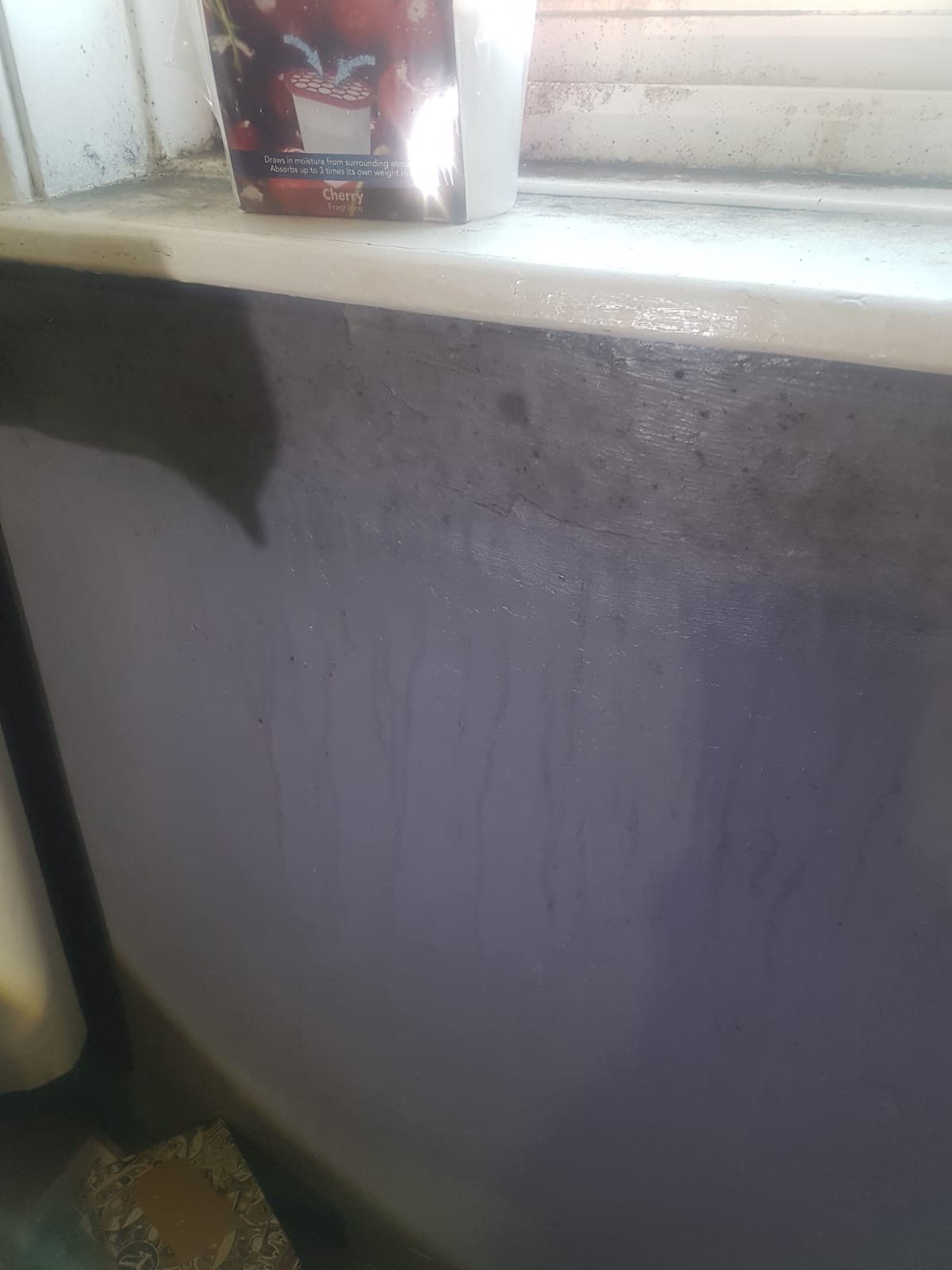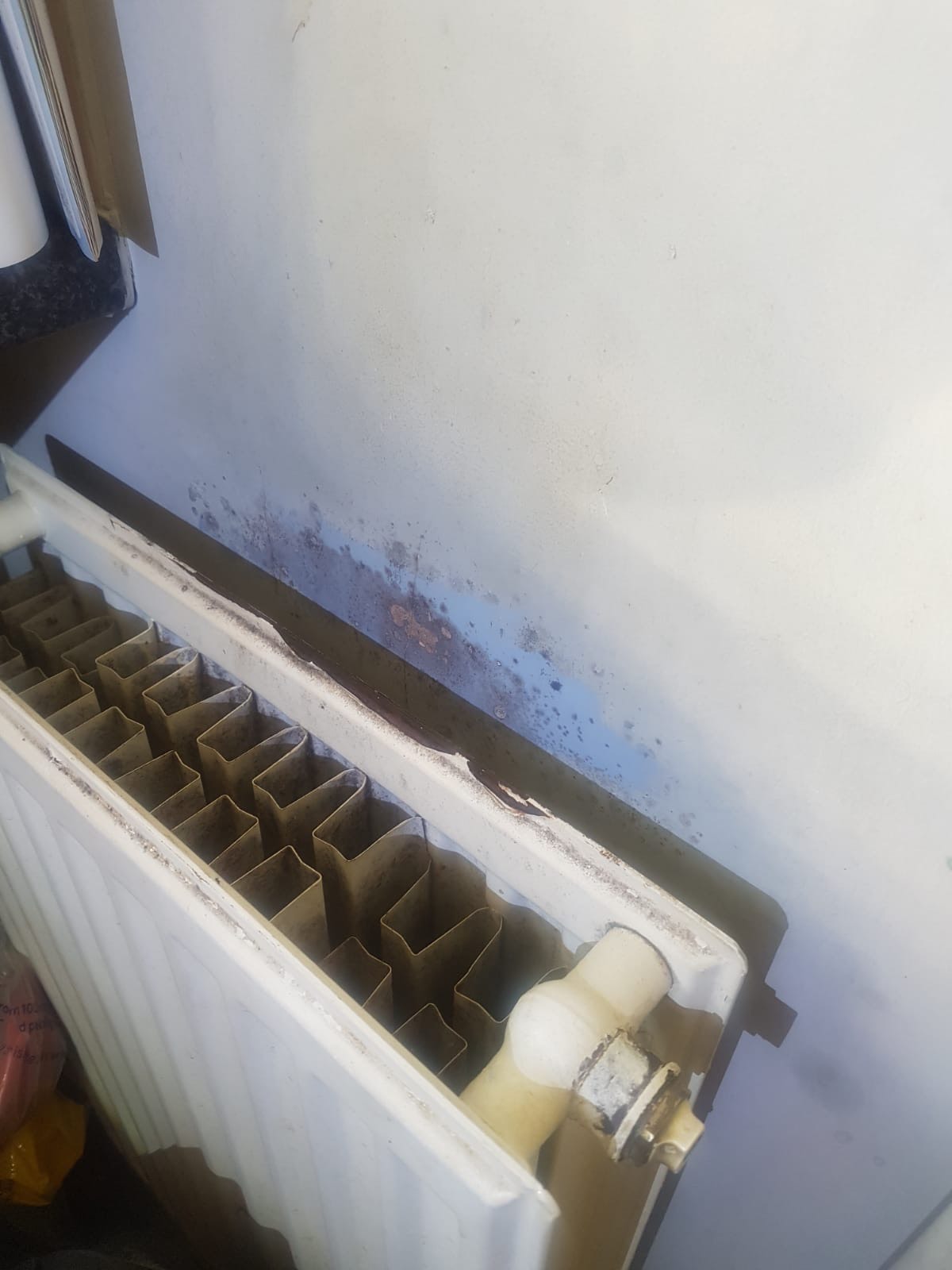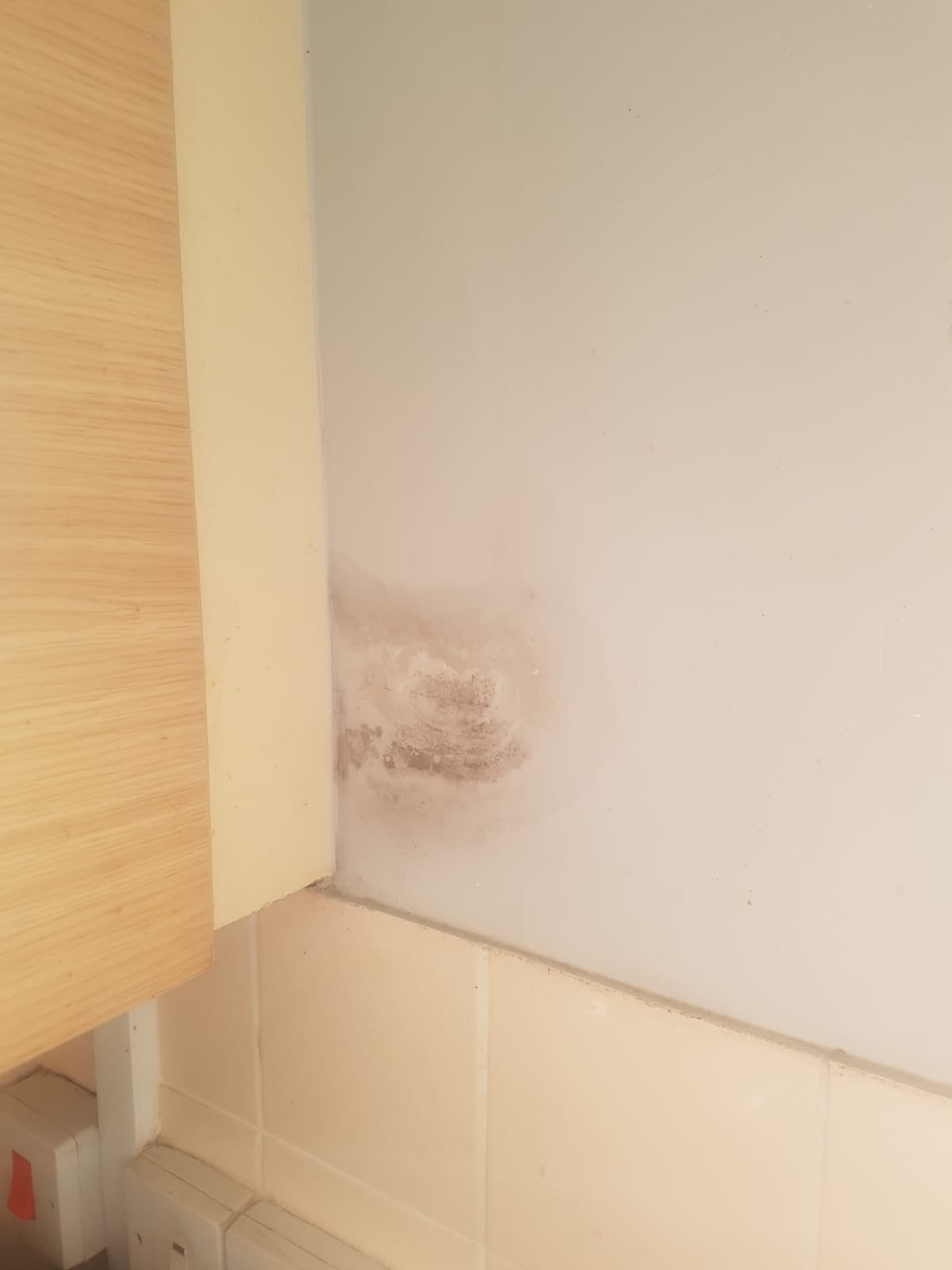Hazmat Loungewear
Because more than one in four of us are living in homes that could make us ill
We shouldn’t need to wear protective clothing in our own home. Yet for one in four of us across the UK, the very places that should be a secure, stable and safe place to live in, are making us ill from issues like damp, cold and mould. These conditions are putting our wellbeing on the line:
- Damp and mould can trigger asthma attacks, worsen respiratory conditions, and cause infections that linger for weeks.
- The cold puts extra strain on our hearts and blood pressure, increasing the risk of heart attacks and strokes.
For older people, it can mean slower recovery from illness. For children, it can lead to more time off school with coughs, colds and wheezing; and for adults, missed workdays and mounting stress.
No one should have to suit up just to stay warm, dry, and healthy at home. Our absurd Hazmat Loungewear concept isn’t the answer. The real solution? Fixing unhealthy homes.
Click the suits to see how government action can make every home healthy.
And we aren’t all impacted equally.
Families on lower incomes are almost twice as likely to have to deal with damp or mould, and four times as likely to live in homes that are too cold. Private renters and people in social housing often have it even tougher — usually because of things they can’t control, like buildings that aren’t properly maintained, long waits for repairs, or not having the money to move somewhere better.
Likewise, people living in homes with damp or other issues are often already vulnerable, coping with things like asthma or weaker immune systems. And almost half of the people affected by damp or mould have children, which means far too many kids are growing up in conditions that can really harm their health.

people in the UK live in homes with issues like damp, mould or cold

of people reporting issues like damp or mould also have children living in the same home

of renters have issues like damp or mould, rising to 23% for those in rented social housing
Our homes are more than just four walls and a roof over our heads; they’re an essential building block for our health and wellbeing. When we live in safe, warm, and good-quality homes, it can add years to our lives.
The North West, West Midlands, East Midlands, and Yorkshire and the Humber have some of the highest reported rates of damp, cold, and mould.
Some people in the UK are living up to 16 years less than others in the UK. Damp, cold and mould in our homes are part of the problem.
Enter your postcode to explore what the life expectancy is where you live and see how it stacks up against the national average.
Explore stories from across the UK on how these issues have impacted people’s lives, worsening their physical and mental health.
-
Tracy Bristol
I’ve lived in this house for 27 years but it was only three or four years ago that the damp and mould started. It was especially bad in the front room, which is my son’s bedroom. We started to see damp around the windows. Last winter the sheets and towels in the airing cupboard in that room were damp and we decided to empty it. It was after this that my son started having chest problems. The exposure to the damp and mould in the cupboard are what caused it.
-
 Helen
Cardiff
Helen
Cardiff
I had really bad damp and mould from the time I moved into my social housing five years ago and it went on and on. I was calling the social housing provider every three days. The damp and mould was really high up my walls in every corner. I was phoning to ask for repairs every three days for six months. My mental health was absolutely crushed. You know, coming home to mould and damp – it doesn’t just affect your physical health, it’s your mind too. It’s depressing. You lose the fight in you, and you want to give up.
-
Lindsey
I do notice days where I’m physically cold, I feel much more depressed. On days where I’m terrified of the cost of putting the heating on, I tend to lay on my sofa, curl up, pull the sides of my jumper up over my chin to stay as warm as possible. It’s quite lonely and I think that’s no good for my mental health.
Unsafe living conditions are damaging health, trapping families in cycles of illness and inequality. The government can take real, concrete action to change this.
We’re calling for a cross-government health inequalities strategy that puts health at the heart of government — from setting realistic but ambitious targets to reduce health inequalities to establishing clear roles for all departments to prioritise and restore the building blocks of health.
Alongside our members, it means pushing for urgent action by the government to ensure everyone has the chance of a safe and healthy home for all, including:
-
Enforcing the Decent Home Standard across all private rented homes before 2035 and applying Awaab’s Law so landlords must act quickly on life-threatening hazards The Decent Home Standards are the rules set by government that social landlords (housing associations and councils) have to meet. These include things like fire and electrical safety, being comfortably warm, being free of dangerous levels of damp and mould as well as being in good repair.
But they don’t currently apply to homes let by private landlords, meaning 1 in 5 privately rented homes in England currently fail the standards, putting health at risk.
The new Renters’ Rights Act will eventually apply updated Decent Home Standards to private rented homes, starting with energy efficiency standards. But the full Decent Home Standards won’t be enforced for private rented homes until 2035 or 2037, according to the current government consultation.
Health Equals and our member organisations like Shelter and Independent Age are calling for these standards to apply and be enforced properly well before then. Similarly, Awaab’s Law was recently brought into force, requiring social landlords to respond to complaints about damp and mould within a set timeframe. But the government hasn’t said when it will be enforce Awaab’s Law for private tenants.
-
Introducing a Warm Homes Plan to cut fuel poverty, improve warmth, and repair homes for those most in need Cold homes don’t just make life uncomfortable — they can make people seriously ill. During the winter of 2022/23, they were linked to around 5,000 excess deaths. Every year, cold and damp homes are estimated to cost the NHS over £1 billion, as they contribute to conditions like asthma, respiratory illness and heart problems, and can also take a toll on mental health.
In 2024, more than 8 million households spent over 10% of their income on energy. We also know from The Health Foundation that problem debt can harm both physical and mental wellbeing. The government’s £13.2 billion Warm Homes Plan is a golden opportunity to change this: to help people struggling the most with fuel poverty and make homes warmer, healthier places to live.
Health Equals, along with our member organisations like National Energy Action, is calling for this funding to focus on those most in need, ensuring they’re among the first to benefit from the shift to net zero. Citizens UK‘s campaign groups are also urging the government to “Fix it First”, making essential social housing repairs part of the retrofit agenda.
-
Setting a clear, cross-government target to halve the number of ‘non-decent’ homes across all tenures and regions of the UK over the next decade Non-decent homes affect people across all four nations of the UK, and in all types and tenure of housing. The vast majority of non-decent homes that are headed by older people are owner-occupied. Over 2.3 million people aged 55 and over live in homes that are cold, damp, or unsafe. Within this, evidence shows that ethnically minoritised communities are disproportionately affected.
All four UK governments need a joined-up plan to cut the number of non-decent homes that will prevent health issues caused by damp, cold and mould. This would include a national network of Good Home Hubs to provide a one-stop shop for home improvement information and advice, as proposed by Centre for Ageing Better.
Your MP wants to know what matters to you. Sending an email might feel like a small action, but it’s the first spark in a chain reaction — from inbox, to Parliament, to policy change.
Right now, there’s a 10-year delay in applying decent home standards to private rented homes. That means living 10 more years in homes that make us sick.
Get them to join our growing movement of change by joining our parliamentary champions network, and ask them to urge Ministers to make tackling damp, cold and mould a key part of a cross-government strategy to reduce health inequalities.
Health Equals is a coalition of nearly 100 organisations who are all working in their own way to address the building blocks of health, including the homes we live in.
as part of broader action to reduce health inequalities
Write to them-
Why hazmat suits? Many people are living in housing with issues like damp, cold and mould and yet the public aren’t always aware of the serious health risks associated with these conditions. We wanted to visualise these health hazards by imagining what kind of clothing you might need to protect yourself from these health harms — to make people pause and reflect on what can be done to ensure people have access to warm, safe and stable housing.
-
Why is the imagery on the campaign so shocking and extreme? Our goal was to make a complex issue visible, personal, and impossible to ignore. We chose to be deliberately shocking because the reality itself is shocking. For those living in comfortable homes, it can be hard to imagine what life is like for families in unhealthy housing. That’s why we created a disruptive campaign and public stunt: to dramatise the devastating health impacts of poor housing and spark a national conversation about how everyone can help campaign for better quality homes for all.
The suits aren’t meant to be appealing. They symbolise an absurd “solution” to a very real and serious problem.
Throughout the process, we consulted our members, supporters, and campaign advisory group; people from the very communities most affected by these issues — and tested the campaign with the public to ensure it resonated both powerfully and respectfully.
-
Are the suits for sale? No, they were just created to raise the issue of the impact on health of damp, cold and mould in our homes.
-
Where did you get the data used in the campaign? We worked with Censuswide to poll 3,892 people across the UK. What we found paints an alarming picture of the scale of the issue:
- More than 15 million people in the UK live in homes with issues like damp, mould or cold.
- People from the lowest income households are almost twice as likely to live in homes with issues like damp or mould (21% vs 12%), and four times as likely to live in a cold home (25% vs 6%).
- Those from low-income households, renters and the West Midlands and Yorkshire and the Humber are particularly affected.
- 21% of renters have issues like damp or mould, rising to 23% for those in rented social housing. And almost half (47%) of households with issues like damp or mould had children living in them.
The survey was conducted online by Censuswide between 24 September and 3 October 2025, using a nationally representative sample. To ensure the experiences of those most affected by poor housing were captured, the research included boosted samples from key groups and regions:
- At least 500 respondents each from the West Midlands, Yorkshire and the Humber, North West, and East Midlands — areas with some of the highest reported rates of damp, cold, and mould.
- Private and social renters, people from lower socioeconomic backgrounds (social grades C2, D, and E), ethnically diverse communities, parents, and individuals living in homes with damp, mould, or condensation.
Additional boosts were applied across key subgroups such as housing tenures, social grades, and other demographic characteristics to enable more detailed analysis of these populations. Where boosted samples were used, weights were applied to ensure the results accurately reflect the national population’s demographics, preventing overrepresentation.
Censuswide is a member of the Market Research Society (MRS) and adheres to the MRS Code of Conduct and ESOMAR principles. It is also a member of the British Polling Council, ensuring transparency and high standards in polling practices.
-
What specific things are you wanting to change through the campaign? We’re calling for a cross-government health inequalities strategy that puts health at the heart of government — from setting realistic but ambitious targets to reduce health inequalities to establishing clear roles for all departments to prioritise and restore the building blocks of health.
Through this campaign, we’re also making specific policy asks on housing:
- Enforcing the Decent Home Standard across all private rented homes before 2035 and applying Awaab’s Law so landlords must act quickly on life-threatening hazards;
- Introducing a Warm Homes Plan to cut fuel poverty, improve warmth, and repair homes for those most in need;
- And setting a clear, cross-government target to halve the number of ‘non-decent’ homes across all tenures and regions of the UK over the next decade.
-
What is the stunt about? We wanted to take our campaign to the streets and educate as many people people about the building blocks to good health, and that some determinants of good health don’t rely solely on personal action and behaviours. Our goal was to get the public to support us in calling on government to deliver a cross-government strategy to tackle health inequalities, starting with housing.
-
Where can I go for support related to the issues raised? We understand that this is a sensitive matter and could impact people in different ways. If you’ve been affected, please visit our support page.

